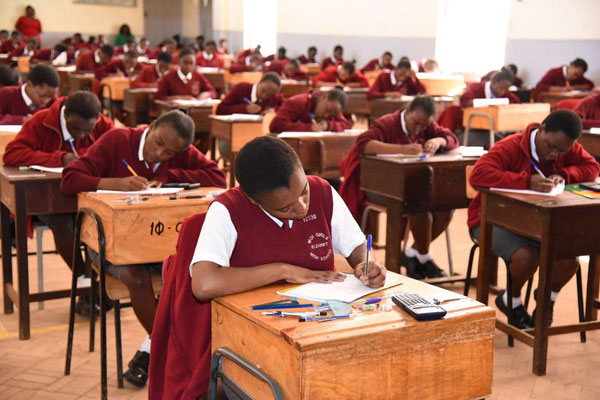
Candidates sitting for the KCSE examination. Photo/KNA
By Newsflash Writer
The government cannot account for more than 700,000 students who sat the 2024 Kenya Certificate of Secondary Education (KCSE) examinations and scored between C plain and E, raising concern over a lost generation slipping through the cracks of the education system.
Out of 961,144 candidates who sat last year’s KCSE, only 246,165 can be traced, according to the Kenya Universities and Colleges Central Placement Service (KUCCPS) Chief Executive Officer, Dr. Agnes Wahome. These represent the students who attained C+ and above, thus qualifying for university entry.
Degree qualifiers versus the missing majority
KUCCPS data shows that the 246,165 students who qualified for degree programmes were distributed as follows: A (7,728), A– (71,695), B+ (19,131), B (43,103), B– (75,268), and C+ (99,240).
The remaining 711,389 candidates, who fell short of the degree cut-off but were eligible for diploma, certificate, and artisan training, remain unplaced and untracked. Under KUCCPS guidelines, a C– qualifies for a diploma, a D for craft certificates, and an E for artisan training. Yet none of these pathways are reflected in official placement figures.
“This is worrying because we have not been able to account for them,” Dr. Wahome told the Senate Education Committee in Mombasa on Friday, prompting lawmakers to demand accountability from the Education Ministry.
An additional 3,590 students received a ‘U’ grade (Ungraded) after choosing to resit individual subjects, mainly in sciences like Biology and Chemistry, in a bid to qualify for medical courses.
Placement outcomes and alternative choices
Dr. Wahome reported that in the 2025/2026 placement cycle, 338,955 students applied and secured positions in universities and colleges. Of these, 182,241 were admitted to degree programmes, 105,757 to TVET institutions, 38,653 to the Kenya Medical Training College (KMTC) across 90 campuses, 500 to the Kenya School of Law for Diploma in Paralegal Studies, and 11,804 to teachers’ colleges.
Read more: Over 42,000 KCSE qualifiers shun university courses
Interestingly, about 25,000 students who qualified for degree courses opted instead for non-degree programmes in TVETs and other colleges. Teachers Training Colleges (TTCs) admitted learners for Diploma in Education, KMTC absorbed students into certificate and diploma health programmes, while public TVET colleges admitted candidates into Diploma/Level 6, Craft/Level 5, and Artisan/Level 4 and 3 courses.
“If students chose private universities, we allow them a month for inter-institutional transfers. Once admitted, they can even switch programmes within two years,” Dr. Wahome explained.
A recurring systemic failure
The crisis highlights systemic gaps in the transition from secondary school to higher education and technical training. Without effective tracking systems, Kenya risks consigning hundreds of thousands of youths to unemployment, wasted talent, and social frustration.
Education Cabinet Secretary Julius Ogamba had, on June 1, admitted that about 50,000 students from the 2024 KCSE cohort were unaccounted for by KUCCPS. This included over 42,000 who never applied for placement and nearly 7,000 who applied but were not placed.
His predecessor, Ezekiel Machogu, had also confessed that more than 631,000 learners from an earlier cohort were excluded from formal placement. KUCCPS acknowledged at the time that it lacked a mechanism to determine whether the students joined private institutions, pursued studies abroad, or abandoned higher learning altogether.
Read more: New plan for repeat KCSE tests as 8-4-4 system nears end
Although the agency says new systems such as the Kenya Education Management Information System (KEMIS) will enhance monitoring, the bulk of school leavers—especially those joining private colleges or informal training—remain invisible in state records.
Dr. Wahome emphasized that applicants are placed based on merit, preferences, and affirmative action. She added that the 2025/2026 cycle prioritizes the 2024 KCSE candidates, alongside others dating back to the year 2000, for placement into different programmes.
The crisis comes as the government faces growing pressure to expand technical and vocational education as a viable alternative to university studies.



